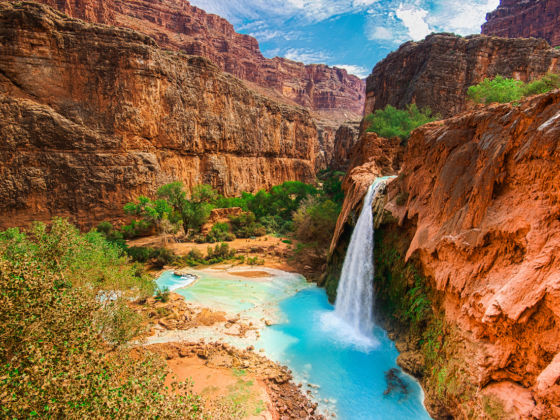1. Hiking the Havasu Canyon trail
Three thousand feet beneath the rim of the Grand Canyon, the five waterfalls of Havasu Canyon are a nearly impossible blue-green shade that even Crayola couldn’t hope to match. One of the most incredible outdoor adventures in the States — whether you decide to hike, ride a horse, or take a helicopter to the falls — the strenuous 8-mile trip between Hualapai Hilltop and the water forces you to earn the spectacular views that await. Once in the canyon, a dirt trail will take you over two small bridges to turquoise swimming holes and waterfalls that reach up to 200 feet high.
For at least the last 800 years, the Havasupai (“People of the Blue-Green Waters”) tribe has lived here and cared for the falls and land around them. When you visit, keep in mind that this isn’t just a tourist destination — it’s a place central to the identity of the Havasupai people.
2. Finding your way to Verde Hot Springs
Verde Hot Springs is one of those local not-so-secret secrets. Once upon a time, the springs were part of a hotel carved into a mountain overlooking the Verde River. In the ‘60s, the hotel burned to the ground, leaving behind plenty of lore and two pools that sit in the old foundation. The larger of the two is completely outdoors and looks out to the Verde River and valley. The smaller and warmer pool is inside a small roofless building that’s covered in psychedelic paintings.
Part of the adventure of Verde Hot Springs is getting there. The unmaintained Fossil Creek Road is an unpaved, suspension-destroying shake fest that twists through naked desert mountains. Once you turn off Route 260 onto Fossil Creek Road, it takes over an hour to drive to the springs campground, so take your time. Pull over and search for the waterfalls, swimming holes, and hiking trails that sit just off the road.
From the campground, you’ll have another mile of hiking before making a river crossing to the springs. If this is your first time, be sure to go during the day. Follow the river toward the old power plant and keep your eyes open for a pile of rocks left behind by fellow adventurers, or use your intuition to find a calm spot of the river to cross. Please bear in mind, you’re a long way from help if you find yourself with a sprained ankle.
3. Mountain biking in Prescott
What makes Prescott so appealing to cyclists is the variety of trails. In a relatively small area, you can find yourself tackling a smooth downhill slope, muscling cross-country, or navigating a technical hill. The Willow Dells Slickrock Trails are some of the most challenging and rewarding, circling through the otherworldly Granite Dells — outcroppings that protrude from the earth like eroded drip castles. In the early mornings and evenings, the still water of Willow Creek reflects the mounds, adding to the surreal feel.
4. Whitewater rafting the Colorado through the Grand Canyon
No disrespect to the rim views of the Grand Canyon, but the only way to truly experience this Wonder of the Natural World is to float through it. For the last six million years, the Colorado River has been at work eroding the canyon into its current superb existence and, by extension, creating one of the most epic whitewater routes anywhere.
Grand Canyon rapids predate the modern Class VI rating scale, so this is one of the few places in the world where, technically, you can see Class 10 whitewater. Crystal and Lava Falls, two of the most aggressive on the Colorado, can be rated as such depending on water conditions. But regardless of when you go and what section you raft, you’ll be treated to rushes worthy of the best amusement parks, and views you can see in Arizona and nowhere else.
5. Off-roading in Sedona
It’s easy to imagine Zeus and the other Greek gods bickering over whether to settle on Mt. Olympus or in Sedona’s sandstone red rocks. During the evening, the massive outcroppings turn a shade of red so intense and worthy of contemplation that they feel like massive antennae signaling to the New Agers who flock from across the planet to admire them.
Like so much of Arizona, Sedona is a place that holds onto its secrets. Many beautiful views are accessible from the road, but an entire world opens up when you have an off-road vehicle and a knowledgeable guide. To accommodate, there are several companies offering jeep tours to remote locations among the red rocks. Trips typically last between two and three hours and will take you to sweeping desert views and the ruins of ancient Native American dwellings.
6. Floating the Salt River
Floating the Salt is a Phoenix-area tradition. Don’t expect rapids or ancient ruins, just happy weekenders tossing back beers, chatting up strangers, and having a great time.
The river runs through Tonto National Forest and is one of the easiest ways to escape the city. About a half-hour drive outside Phoenix, you can leave your vehicle, rent tubes, and get bused to the drop-off point. Your float through the desert landscape can last anywhere from two to four hours, and there’s no overstating the importance of making room for lots of water in your cooler and keeping a cap on your head. That Arizona sunshine can be mean.
7. Hot-air ballooning over the Sonoran Desert
How do you rise above the natural challenges of the desert — spiny plants, venomous animals, baking temperatures — to appreciate the inspirational landscape that’s home to the only jaguar population in the U.S.? Well, you rise above…
Hot-air balloon tours operate across the state, but the opportunity to see southern Arizona’s Sonoran Desert from the sky make those in the Phoenix and Tucson areas especially appealing. Start early in the morning to take in one of the most arresting sunrises on the planet. Once the sun’s up, keep your eyes trained on the ground to catch glimpses of Sonoran pronghorns, coyotes, and javelinas.
8. Skydiving
If the hot-air balloon didn’t get you high enough, head into the air by plane. Thanks to Arizona’s warm climate and chronically clear skies, the state has developed a robust skydiving scene. Hardcore skydivers come over from Europe to make desert jumps at several sites between Tucson and Phoenix. Whether you’re a first timer going on a tandem jump or a long-time veteran of the air, skydiving in Arizona provides the ultimate adrenaline rush.
9. Staying on a dude ranch and riding off into the sunset
Staying on a dude ranch in Arizona provides both (family-friendly) outdoor adventure and the amenities usually found in all-inclusive resorts. Ranches typically offer guided horse tours of the surrounding land and, depending on the particular ranch, you may find yourself herding uncooperative cattle, going on a desert hike, or even playing on a world-class golf course. By the time the sun goes down, your belly will be stuffed and the evening’s entertainment of staring into the overcrowded parking lot of stars in the sky will commence.
10. Walking in Geronimo’s shadow at Chiricahua National Monument
Chiricahua National Monument is a maze of volcanic rock spires in the southeastern corner of Arizona. Boulders balance on top of each other so precariously it can feel as if the laws of physics have been suspended.
Covering nearly 12,000 acres, this is where Native American warrior Geronimo and other Apaches hid and planned attacks against the invading U.S. Army. Today, the national monument is notable for hiking trails and birdwatching — look out for bald eagles and prairie falcons. For an unbeatable view, be sure to check out Massai Point.

